- Accueil
- Louis Vuitton
- Modeles
- Toiles
- Serrures
- Lozines
- Etiquettes
- Séries
- Expertise
- Prix du neuf
- Record enchère
- Stars LV
- Contrefaçon
- Nouveauté 2025
- Vanity
- Valise
- Cabine
- Courrier
- Wardrobe
- Automobile
- Fourrure
- Chaussures
- Ideale
- Aluminium
- Explorateur
- Malle à fleurs
- Cadeau VIP
- Jouets
- Chapeau
- Leopold Stokowski
- Albert Kahn
- Tableau
- Lit
- Tiroirs
- Bibliotheque
- Aéro
- Cigare
- Pique-nique
- Alcool
- Pêche
- Marmotte
- Steamer Bag
- Vermeer
- Vendôme
- Georges Vuitton
- Gaston Vuitton
- Homme cible
- Sac petite malle
- Goyard
- Moynat
- Hermès
- Malle ancienne
- Entretenir sa malle
- Estimation
- Lexique
- Décoration
- Personnalisation
- Etiquette Hotel
- Blog
- Louis Vuitton
- Contact
- Ateliers
- Tutoriel : Fabriquer sa malle
- Boutique
HOTEL LABELS - OLD TRUNK
STORIES AND JOURNEYS

Luggage tags have their fans and collectors.
As there are collectors of: pin's, cigar rings, enamel plates, advertising pens, muzzle plates, stamps, telephone cards...
Often kept by the traveler himself as a souvenir of his travels, they are rarely dated. Their popularity owes everything to the Americans and the English who take pride in showing off their trunks, all colorful with the labels of the hotel they have been in, on their return from their trip, making one dream of distant horizons.

Gaston Vuitton , grandson of Louis Vuitton, amassed a unique collection of 3,000 hotel labels during his lifetime. He wrote a book on this subject in 1920, excerpts from which you will find at the end of this article. Gaston calls hotel labels " small posters ".
His testimony is of great historical richness to understand the practices and uses falling within the context of a past era.
The first color luggage labels appear around 1900, until 1960. They are closely inspired by travel posters of the same period. They are very colorful, of various shapes and bear witness to the marvelous journeys of the owners of the trunks. Today it is historical archives.
The labels are stuck on luggage by hotel staff in order to promote and publicize the hotel establishment. It is therefore an advertising approach, because the trunk traveled everywhere, around the globe at a time when advertising distribution had a restricted field. (no television, internet, international media...)

The hotel labels are not reserved for luxury trunks, Goyard , Louis Vuitton, Moynat , Hermès , they are also found on old anonymous trunks.
Extract from Louis Vuitton Automobile Catalog 1906 (Page 21):
Two "car trunks" from Louis Vuitton
Having completed a tour of Europe
Louis Vuitton
OTHER LABELS FOUND ON OLD TRUNKs
On the trunks and suitcases there are not only hotel labels, there are shipping labels for transit , a label for each place where the trunks passed. They have no decorative vocation, they are glued successively on top of each other to facilitate readability and therefore transport. Tags play an important role in the search for lost baggage. Indeed, when a piece of luggage is misplaced, it is generally because the label which identifies the luggage has been torn off, because many labels are hung with a simple cord,which has the disadvantage of being able to come off during handling, hence the reason that the majority of labels are stuck on luggage, the most common are:
-
Railway company labels
Bearing the name of the points of departure and destination, as well as the registration number which will allow on arrival to regain possession of the luggage entrusted to the carrier. Very numerous, never colored, they successively stick to each other.
-
Special train labels
Where the typography on a colored background must arouse the attention of the employee in the baggage service.
-
Large international express label
They are generally rectangular, cut diagonally by the description of the route, thus leaving free two triangles most often in the colors of the flags, one of the country of departure, the other of the country of arrival.
-
Airline tags
play an important role in finding lost baggage. Indeed, when a piece of luggage is misplaced, it is generally because the tag that identifies the bag has been torn off.
-
Transport labels
Just like today, you could send your luggage as you send a package (by sea, land, or sky). Some transport companies also specialized in transporting luggage from stations to homes.
-
Baggage service cruise labels , best-known Transatlantic General Company: French Line, United States Lines. The class also appears on the label: 1st / 2nd / 3rd / 4th class (hold baggage)
-
Auction house labels
Designating the lot.
-
Customs labels
With all customs procedures
- Public storage labels
-
Owner's address labels
Just as today all trunks were labeled with the owner's address. For the most luxurious trunks with a label holder, for the others a paper stuck more or less carefully and directly on the trunk.
-
Storage labels
At the end of the life of the luggage when it is then used for storage in an attic, the owner sticks a label and writes its contents on it.
- Etc ... (non-exhaustive list)
URBAN LEGEND, THE LANGUAGE OF LABELs
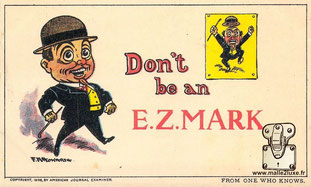
Franklin Morris Howarth (1864-1908) was an American caricaturist and pioneer comics artist. Howarth, whose style for figures often featured large heads on small bodies, was among the first generation of caricaturists to create "series" of cartoons (4 to 6 vignettes), which came to be called comic strips,
He created around 1900 the character EZ Mark , for the Sunday newspaper: American Journal Examiner
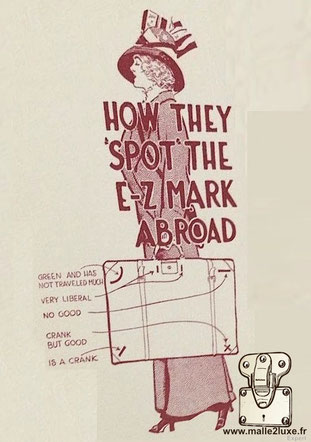
The main characteristic of the character is summed up in his name :
- the letters EZ are pronounced EAZY, which means EASY
- MARK means in English also a "target person of scam"
In the EZ adventures Mark was a wealthy, but very gullible character, constantly being cheated. The gags put him in situations where he was so dumb that any scam, without any violence worked on him.
Following this series in 1906 American Journal Examiner publishes this humorous illustration when we understand who EZ Mark is.
Following this publication 14 years later, Gaston-Louis Vuitton publishes in " the iconographic journey around my trunk " of which you will find the extract at the bottom of this article, a drawing called " the language of hotel labels ". This drawing is a faithful representation of the illustration whose source is quoted by Gaston-Louis.
" some "... " If we believe it ", Gaston-Louis Vuitton recounts all the information he was able to collect, including this very amusing anecdote which would reveal the specific and universal coded language of the world of the hotel industry. Allowing all porters, baggage handlers, porters, bellboys, concierges, chambermaids of palaces on the planet to gauge, at first glance at the luggage, the profile of its owner classifying it from "very generous" to "bad" when it's about tips.

Urban legend :
Of course, this is a legend, it is inconceivable that in a luxury hotel, employees devoted to service, have so little consideration for their wealthy customers and have so much contempt to write on a luggage at the view of all, chalk symbols or arrange the labels in such a way, to warn that the owner of the luggage is particularly "STINGY".
CONSERVATION State
The labels are made of simple paper , of poor quality , unvarnished. The reverse is covered with an Arabic glue ( reversible water-based glue like postage stamps). They are most of the time in perfect condition when they have never been glued because they have been kept away from light and humidity.

On the other hand, those stuck on the trunks and suitcases, are placed temporarily,without much precision, (like an advertising poster stuck on the walls). They were not intended to last, often stuck on top of each other.
Between exposure to air (variation in humidity), to light (uv), to bad weather (rain) and to dust (which becomes embedded in the fibers of the paper) for decades, often more 60 years old. They therefore unfortunately reach us for a very large majority of cases that are illegible , unsightly, the colors fade , the yellowed paper dries before disintegrating into small pieces , a label is never complete.
It is not uncommon to see very old labels coexist with other more modern ones. For example, the last tags applied may be those of an air transport for repatriation, or a storage tag, applied after the life of the luggage, because the house staff regularly removed the altered tags .
Thanks to this observation, it is very easy to see which label is old and which is not.
EXAMPLE OF DIFFERENT HOTEL TAGS LEFT ON LUGGAGE
You will find below trunks in their juice with their original labels. Reality :
RESTORATION AND CONSERVATION
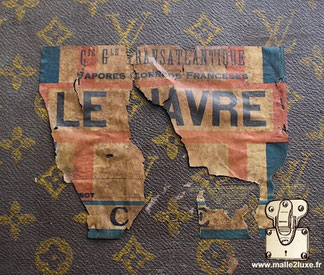
It is not possible to restore the paper of the labels on the old trunks, nor to find the altered colors, nor to bleach it. At best, we can stabilize the current state within the framework of conservation, but it will then be necessary to store the trunk with its labels , protected from light, in a controlled environment (temperature and humidity of the air) to slow down the degradation. , and do not touch it again.
Example, this label is 80% complete, but of which 3/4 are no longer stuck, the slightest transport (delivery) would be fatal to it. Yet the colors are still beautiful and its inscriptions perfectly legible.
As part of a restoration
- The restorer must choose whether to restore the trunk, to the detriment of the labels.
OR
- Label them at the expense of the trunk.
It's a choice to be made , in most cases the trunk is considered more important than the labels. The latter, finally what is left of them, are withdrawn. Some labels even if in average condition are kept because removing them would reveal the traces. We will talk about this a little later in this article.
For each restoration we find the legibility of the object, we find the original surface but we lose information hence the importance of photographing each element in order to constitute a file, before intervening.
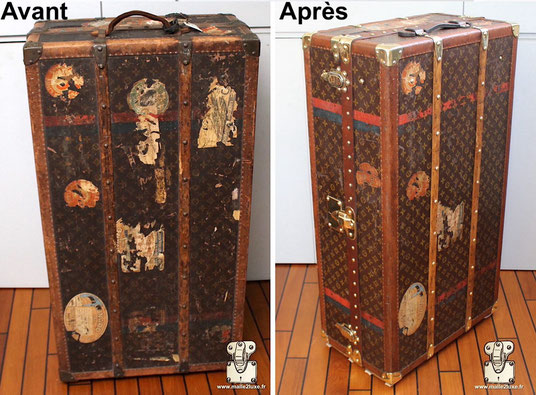
Case study :
In rare cases, the trunk can be restored, damaged and illegible labels removed and the copies kept in good condition.
Example on this old Louis Vuitton Wardrobe from Miami, where we have chosen to remove the illegible labels and keep the rare copies which are in exceptional condition (but given that they are original, it therefore remains very damaged and faded), On this trunk, the labels kept represent less than 36% of the labels present.
HOTEL ETIQUETTE mark

To determine if a label is part of the history of the luggage, unlike train labels (even if they can leave traces when several are stuck generously on top of each other), hotel labels are stuck with a strong glue , over time the glue polymerizes with the support, in this case the coated canvas. The paper shrinks with variations in humidity, during its movements, the glued paper constrains its support (therefore the induction of the canvas) creating cracks around the glued surfaces.
Also the covered surface is protected from UV and therefore will not "patinate" in the same way as the rest of the surface, especially on leather trunks, and checkerboard canvas, and yellow vuittonite.
And when the label is removed (or removed by itself) it leaves room for a trace, corresponding to its initial location. They're called "tag traces."
On a complete label, there is a boundary between the uncovered coated fabric and the edge of the label. Conversely, a label recently added to a trunk in a stable environment (temperature and hygrometric variation) will not make any mark.
BEWARE OF LABELS THAT HIDE DEFECTS
As you have now understood hotel labels, once stuck on, they do not keep well, they turn yellow and disintegrate very quickly, before falling off on their own. It is not possible to restore paper.
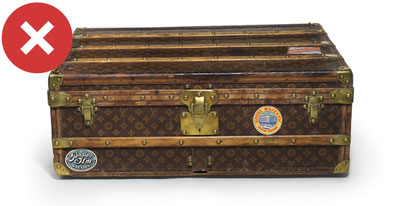
However, you will see many trunks for sale at merchants who have beautiful hotel labels, with bright colors. These unscrupulous sellers do not hesitate to stick real labels to facilitate the sale, and to attract often foreign customers:
-
Hiding defects
What could be simpler than hiding with a label, a defect, such as a tear, a hole, lack of canvas, traces of label, or other imperfections... etc.
- Some merchants have made a specialty of adding to each of their trunks labels still in perfect condition stuck on to decorate and invent stories of distant travel, so according to the seller they "prove" that the trunk has "really traveled" and what is "really old".
Of course, the trunk remains authentic, it's just important to reestablish a certain truth and to be aware that your trunk may not have the story that was sold to it. All the trunks that have traveled have labels in their time, but rare are the ones that reach us in their original condition, at best an old, unreadable yellowed paper, at worst a trace on the canvas but never a colored label. in a perfect state. Or if there is one in perfect condition, there are 10 others altered, enamelled and damaged around it.
ILLUSTRATION OF LABELS ADDED BY THE SELLER








PRICE OF A HOTEL LABEL FOR TRUNK
Old luggage tags, have no great financial value, it is possible to buy original copies for a few euros depending on the condition, the hotel, the illustrator, the rarity and the style.
Old label price taken off from a trunk: from 0.10 euros to 2 euros.
Price of a new stock label that has never been stuck on: from 1 to 10 euros.
EPILOGUE - HOTEL ETIQUETTE
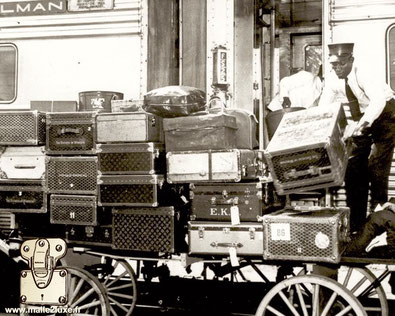
As you have understood in this article, the labels stuck on the trunks were not left permanently on their trunk, only certain hotel labels are sometimes kept. The valet took care of removing them each time he returned from a trip so that the luggage regained an apparent "cleanliness".
The more luxurious the trunk, the more the owner is attentive to elegance, it is about his own image.
The label's function is to QUICKLY identify its destination passing from hand to hand on the unloading docks, the more labels and information there are, the greater the risk of error. It is for this reason that the labels are glued on top of each other to leave only one visible, the oldest being torn off and crossed out. The trunk acts as a "package" without cardboard packaging. And all the vintage photos point in this direction.

Location of labels
The train labels are necessarily on the side of the trunk, the trunks being stacked on top of each other, it would not be readable otherwise.
Hotel labels are often on the side, sometimes the top, rarely the front, never the bottom of the trunk.
They are never positioned at the bottom of a trunk, nor in the corners. This is the sign that the label hides a hole. The holes are more often at the end of the luggage.
Example label added to hide restoration defects.

At all times there have been "marginals", bourgeois bohemians, backpackers and globe trotters. They like to show off and abuse it, but rare are those who travel in Louis Vuitton. So let's not generalize, it's a minority.
Contemporary fantasy takes precedence over History.
Just like today, few people keep parcel labels (colissimo, chronopost, ups, etc.), or leave plane boarding lAt all times there have been "marginals", bourgeois bohemians, backpackers and globe trotters. They like to show off and abuse it, but rare are those who travel in Louis Vuitton. So let's not generalize, it's a minority.
Contemporary fantasy takes precedence over History.
Just like today, few people keep parcel labels (colissimo, chronopost, ups, etc.), or leave plane boarding labels attached to their luggage.
ANECDOTE: COLLECTIONISm
During this investigation, we could not finish this article without talking about "collectionism" Definition editions Larousse:
The pathological need to collect useless and worthless motley objects.
It is obvious that the "collectors of hotel labels" in the majority of cases are not collectors of luxury trunks. And to end on a touch full of mischief.

Did you know that there are also:
- Tyrosemiophile:
Cheese label collector.
- Alcoholism:
Wine bottle label collector.
- Legufrulabelophilia:
Fruit and vegetable label collector.
- Salsicophy:
- Sausage Tag Collector
ICONOGRAPHIC JOURNEY AROUND MY 1920 TRUNK BY GASTON VUITTON
Iconographic journey around my trunk - 1920s
Extract from the Bulletin of the Archaeological, Historical and Artistic Society - The old paper
This testimony and exceptional anecdote from Gaston Vuitton helps us to better understand the context and the manufacture of hotel labels . Excerpt from page 9 to 12:
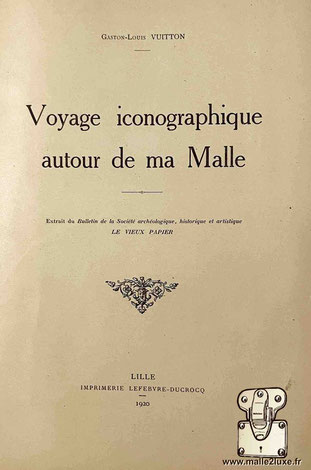
Some wanted to see in the way the small posters are pasted a code allowing hotel people to correspond with each other and to signal the value of the customer, from the tip point of view. If we believe the "American Examiner " it is not so and it is with the help of chalk marks that this correspondence is established:
- A quadrant in the upper corner of your suitcase means "A bruise, hasn't traveled much yet", it should be treated appropriately.
- A straight line on each side of the " very generous " lock;
- a horizontal line in the upper right corner " bad "
- if this line is accompanied by a V, oh! then " terribly bad ";
- a diagonal mark at the lower corner “ an unpleasant crampon ”;
- a cross in the lower right corner " crampy but generous ".
And very wittily the article lists how you will be received in hotels according to the sign on your luggage. He frankly admits that waiters have a hundred sophisticated ways of making the life of the man who does not tip miserable, while the man who tips, as the English word goes, will have a life of enviable comfort and luxury.

The posters are ordered from printers in varying quantities, but rarely less than 5,000 and the maximum reached seems to be 25,000.
Prices in 1914 varied in France between 12 and 30 francs for 1000 units (i.e. 38 to 95 euros today (1 fr (from 1914) = 3.19 € (from 2020)) , while Italian printers accuse a starting price of 8 lire to go up to 55 lire.
No special format, and an unlimited number of shapes: square, rectangle, diamond, round, oval and special shapes ranging from the crest to the cut pattern. The greatest fantasy reigns and it does not contribute little to the attraction of these small posters.
Printers seem to have specialized in these editions, thus this collection has 433 pieces, of which 183 are without publisher's name; 65 come from Boutillier in Paris; 49 from Richter in Naples; 45 from Trub in Aarau; 16 from Orell Fussli in Zurich; 5 from Papeterie Universelle, Lyon and Paris; 4 from Sonor in Geneva; 4 from Imbert in Grasse; 3 from Lange, Duvoye, Bourgeade and Rosen in Paris. Finally Arnaud in Lyon, Imprimerie Provençale in Marseille, Korsand in Frankfurt, Odenwald in Baden, Ricordi in Milan each registered with two posters, while 35 various printers were each represented once.

The poster as we have said is an advertisement; advertising that the hotelier does somewhat to the detriment, or at least at the expense of his client, but what does this one say?
What does the owner of the trunk say, taken as a support, as a medium for hotel advertising?
Some rebel, balk, and go so far as to threaten to withhold any tips if they don't respect their baggage. They are a tiny minority while the majority made up of the indifferent lets it go. When there is a plethora, they will ask their valet to clean the trunk.
Collectors form an important group, but who says collector also says a little, maniac, therefore personal feeling and inevitably a lot of variants.
This one will leave to the porter (In the hotel industry, the waiter is in charge of receiving the luggage, taking it up to the apartments, going down to the basements, etc.) the care of sticking the small posters where he wants, but he will formally forbid his trunk maker to touch these posters when he gives his trunk to be checked.
Anyone else who knows that porters often try to hide with their labels that of a hotel that does not belong to their group, group of Ritz - Carlton, Ruhl, Negresco, Marquet, etc... in front of him the poster on his trunk he will take care that it is well placed between the slats which will protect it and that it does not cause harm, by its dimensions or its color. to its neighbours.

Finally we have the one who asks for the posters and slips them into the taping (Taping a trunk is to line the inside of its lid with ribbons) from the inside of the lid of the trunk, each time he opens it he has the spectacle of it, he is a dilettante, the posters thus remaining intact.
Finally, I kept the false traveler. On his new trunk he has the small posters collected from right and left or that he has had friends bring to him. HE wants to have travelled. Often, he only visited Deauville or Nice, and never sailed to the Americas.
Where could these posters be collected?
By profession, many trunks pass before my eyes and for a few years I had put aside the most interesting of the peeled posters when a trunk is given to us to "clean", unfortunately they have often been stuck on for a long time or covered by transport company labels and we know how generous the employees are with their glue and how despicably dirty it is!!! Hence the need to soak them long enough, which, impossible in some cases, forces them to be removed with a knife. So the poor poster suffers terribly, and it's all bruised that it enters the collection.

I put them there regardless of their condition. They mark their place while waiting for luck to favor me with a complete and clean copy. And then they give the entire portfolio a bit of that precious “Old Paper” look.
Here is the first source, it should be the only one and in reality is only a limited contribution.
The second source is the request that we make for a few copies to the concierge of the hotel where we are. To make this request, it is good to choose the moment before the moment when you are going to give the tip. , you're sure to get your door hangers and a gracious smile, because unlike the building superintendent, the hotel superintendent is always friendly. Not only will you do this harvest yourself, but you will ask your friends to help you, the posters from the most distant countries have thus been brought to me by Mr. Émile Schmidt to whom I express my thanks here.
Third source, the request by letter addressed to the hotelier.
The fourth and last source would be exchange or purchase and I couldn't
resort.
I would not like to end without addressing my lowest thanks to the
Printers who were kind enough to answer my questionnaire. Not only do they
answered me but they attached to their answer, packets of labels.
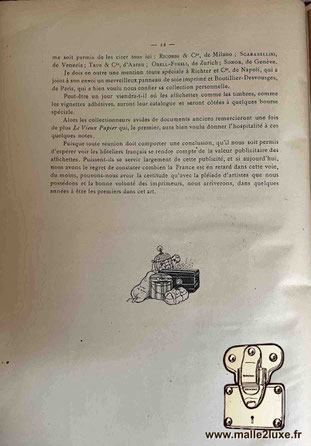
Allow me to quote them all here: RicORDI & Cie, of Milano; SCARABELLINI,
from Venezia; TRum & Cio, of Aarau; ORELL-FUssi, of Zurich; SoNoR, from Geneva.
I also owe a very special mention to Richter et Cie, from Naples, who included a wonderful printed silk panel with his shipment, and Boutillier-Desvousges, from Paris, who was kind enough to entrust us with his personal collection.
Perhaps a day will come when small posters like stamps, like adhesive labels, will have their catalog and will be listed on some special exchange.
So the avid collectors of old documents will once again thank Le Vieux Papier which, the first, will have been kind enough to give hospitality to these few notes.
Since any meeting must have a conclusion, let us hope to see French hoteliers realize the advertising value of small posters. May they make extensive use of this publicity, and if today we are sorry to see how far behind France is in this direction, at least we can be certain that with the host of artists that we have and the good will of the printers, we will manage, in a few years to be the first in this art.
Thanks to Christophe B. for lending us his book to publish this excerpt.
BOOK LOUIS VUITTON HOTEL ETIQUETTE - FRANCISCA MATTÉOLI

Book: Stopovers around the world. Hotel labels from the Gaston collection - Louis Vuitton
Date: 2012
Editor : Xavier Barral
Texts: Francisca Matteoli
Language : French, English or Japanese
Hardcover: 514 pages over 1000 illustrations
Item Weight: 1.45 Kilograms
Dimensions: 17.3 x 4.6 x 24.5 cm
From Paris to Rio de Janeiro, from London to Tokyo, they invite us to travel around the world in twenty-one stops following the routes of the great ocean liners of the first half of the 20th century. Exotic, poetic, playful, more than 1000 labels from this fabulous collection are presented in this book.
READ MORE :
Etiquette hotel : French page
Copyright © 2008-2025 Malle2luxe Paris. Tous droits réservés.



























































































































